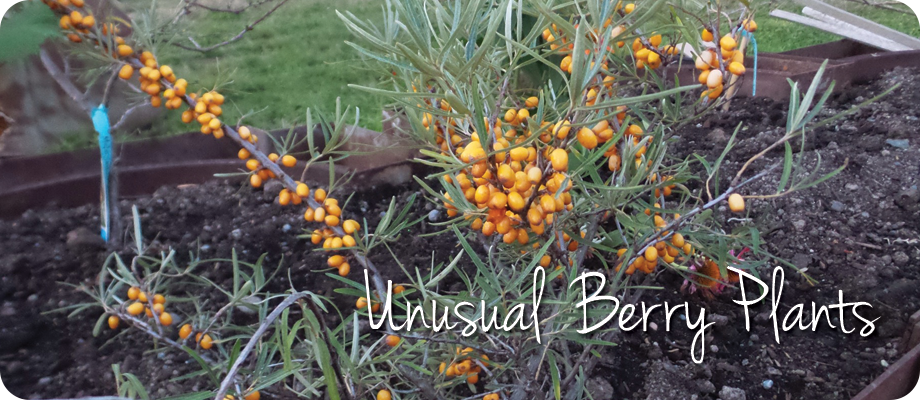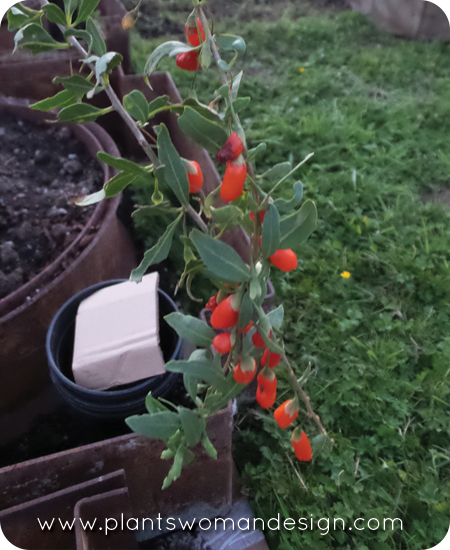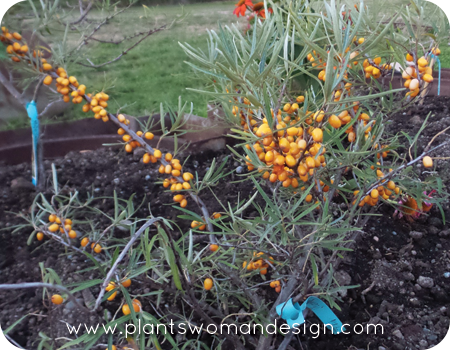While searching the nursery for Rhubarb I came across some interesting plants. While not finding the rhubarb I didn’t come away empty handed. My little finds didn’t look that great in their 1 gallon containers but I have faith that it will be an interesting experiment. It is amazing how many little experiments I try.
My first little find is the Crimson star TM Gogi Berry. It had fabulously interesting fruit hanging from long wand like branches. I even took a taste of the hanging orange berry. Not only is it good for you it tastes good which I usually see as a dried fruit and in juices.
The next little guy I found is a Lycium barbarum variety of Gogi Berry Plants and Garden Harvest Supply had some good advice…
“The Lycium barbarum variety of Gogi Berry are a perennial in zones 3 to 10, they are actually quite remarkably heat and cold tolerant. Goji plants are deciduous, which just means that they drop their leaves every year, usually once the first frost hits. Goji Berry plants are very adaptable, but for the very best results, test your soil, and then adjust the pH to between 6.8 – 8.1. You can add lime to raise the pH if necessary or aluminum sulfate to lower it.
I also picked up a male and female Sea Berry, of course the berry is orange too. Here is some great info from MySeeds, “The Hippophae rhamnoides has plenty fans to recommend it as the Sea Berry is widely used for healing in Asia and Europe, where it is valued as a potent anti-oxidant, a source for Vitamin C and a healing oil. The attractive small tree or shrub, also called Sea Buckthorn, is likely the most widely grown, northern hardy, fruiting plant in the world, but most Americans have never heard of it! In Europe, the sour, flavorful fruit is sweetened and its orange-passion-fruit-like flavor makes fine sauces, jellies and a base for liqueurs. The plants, native to the Russian Far East, are incredibly productive and a great choice for backyard fruit production! Narrow silver leaves and plentiful round, yellow-orange fruit cover the 6-10′ tall, narrow, upright female forms. Give plants full sun and good drainage, and space them about 7′ apart or 3-5′ for a hedge. They are extremely hardy, to -50° F., disease resistant and easy to grow. Branches are used in floral displays, and commercial crops are harvested by cutting off entire fruit-laden branches. USDA Zones 3-9.” If you miss it in the nursery you can get it at Raintree Nursery on line. (source)
Less unusual but still a breakthrough that fruit growers in small gardens are excited about is the Raspberry Shortcake bush type raspberry. These are not running out of control canes everywhere type of raspberries. I got good production in my Miller Bay garden. This revolutionary, thornless raspberry is a little dwarf of a raspberry with an endearing compact growth habit that thrives in patio pots or in your landscape. It needs full sun, fairly neutral soil, moderate watering and good drainage. Fertilize in early spring with a balanced liquid fertilizer. It needs some chill factor. If leaves begin to yellow or droop in summer – apply a balanced liquid fertilizer and water well. It does have a compact habit and if planted in the landscape it will still produce new canes around the base of the plant. If you want it to stay in a container it is happy to oblige! (source)
I dropped one into the same garden bed as the Goji and Seaberrys. Of course the designer in me can’t resist adding a few accent plants while I’m at it. These Echinacea ‘someadobe’ have a fabulous color of orange with little bits of hot pink at the edges of the petals. Yummy color!





I planted a gogi berry shrub and this was my first batch of berries this year. I should have my first full crop next year so I am anxious to see what I can make of the berries.
I’m excited to see what it looks like in a year and experiment with the berries. Keep me posted on what you do.